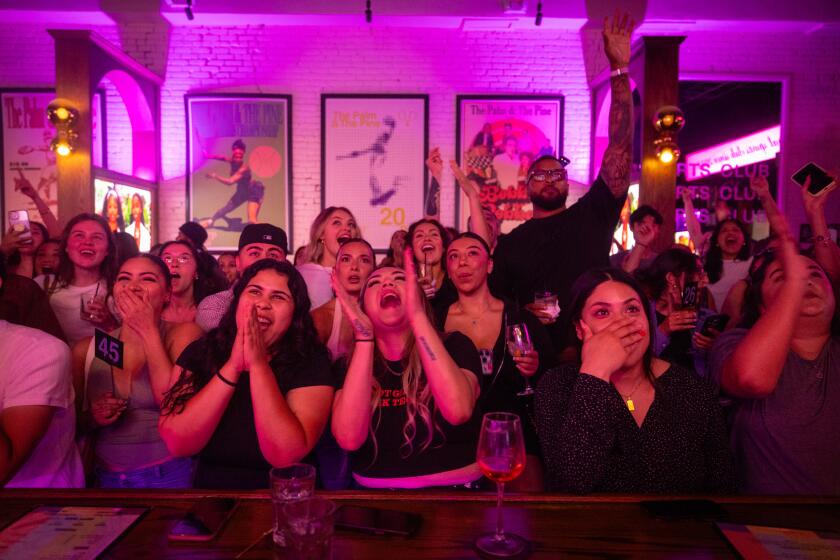Museum Doesn’t Forget That Dolls Are Toys After All
- Share via
The Mary Shaw Doll and Toy Museum is not a roped-off “don’t touch” kind of place.
Pee Wee Herman rubs shoulders with antique porcelain figurines. Raggedy Ann shares shelf space with a hand-carved wooden soldier. And, within limits, visitors are free to handle items on display at the museum, on a downtown La Puente street that is lined with auto repair shops, check-cashing establishments and billiard halls.
“We’re just a place where people can come and enjoy dolls,” said Wyatt Seal, the soft-spoken museum director.
He makes no attempt to explain the dolls’ cultural relevance or artistic style. His emphasis is not on amassing a priceless or historically significant collection. But the museum’s panorama of playthings suffices to bring smiles to the scores of people who have visited and taken the tour.
They crowd around the themed doll displays, laughing at Seal’s corny jokes and marveling at the toys and gadgets pointed out by tour director Susana Lozano.
Their eyes glow at the sight of the museum’s shelves, bursting with dolls, toy trucks, games and stuffed animals.
“Do you have Gidget?” one young guest asked recently, as she stared at a display case full of Barbie dolls.
Visitors are encouraged to “interact” with the collection, which includes Cabbage Patch Kids and dolls from Poland, Holland, the Dominican Republic and Mexico. It has new dolls, such as Masters of the Universe figures, and old ones, including the hand-carved wooden soldier from Bulgaria, which was made in 1899.
Although unsupervised play is not permitted, Lozano hands around selected items and demonstrates others, such as a toy train or a mechanical barking puppy.
Seal’s policy is to accept any doll or toy that is donated or loaned. In the 15 months since the museum opened, 47 children and adults have found a good home for their dolls and toys at the Mary Shaw museum.
“One little boy donated a Batman figure. Another time a young man came in just to kill time, and a few days later he came back and brought some black-and-white clown dolls for us,” said Lozano. “It just happens that way.”
“A lot of times the kids’ mothers are bugging them to get rid of some of their old dolls and toys. Here, they know they can always come and look at them, and they’ll never be thrown away,” Seal said.
That’s what prompted Mary Shaw, 74, a volunteer at La Puente’s nonprofit Delhaven Community Center, to donate her doll collection to the center in May, 1988.
“I couldn’t bear to just sell them off,” said Shaw, who had gathered the collection over the course of 30 years. “I wanted somebody else to enjoy them like I did. When girls, even grown-up girls, saw my collection, they would say, ‘I used to have one like this but my mother gave it away,’ or ‘I don’t know whatever happened to my dolls. I wish I had them back.’ ”
So Shaw offered her dolls to the center. The Delhaven staff thought she was talking about three or four dolls, a dozen at the most.
“We sent a fellow out to pick them up with a little truck, and she had 800 dolls she wanted to give away,” Seal recalled.
Not knowing what to do with all the dolls, the Delhaven staff held a meeting and came up with the museum idea.
The community quickly took the idea to heart.
Tom Ferranti, a local magician, volunteered to give free magic shows for groups touring the museum. A local doll collector brought over her framed jigsaw puzzles to decorate the museum’s walls. Volunteers built the display cases with donated materials. Start-up costs amounted to $120.
Since Dec. 14, 1988, the little museum has hosted about 50 tour groups, including visitors from day-care centers, service clubs and retirement homes. “Lots of times, people just happen by and come in to look around,” said Seal, who also is program director of the community center.
There is no admission fee. “The community we’re in isn’t that well-to-do, and we didn’t feel it was right to charge anything,” Seal said. “Most people make donations, whether it’s three or four cents or a few dollars.”
Day-old baked goods are offered for sale, with the proceeds used to help operate the museum.
The collection has grown rapidly to more than 1,700 dolls and toys, and now it needs more space. Seal said he hopes to move it into larger quarters near the Delhaven Thrift Shop this summer.
But spacious surroundings aren’t very likely to change the museum’s spirit.
Seal pointed to a huge, stuffed dinosaur perched on a ledge over the doorway. “A group of kids from a treatment center for the emotionally disturbed toured the museum and one boy told us he wanted to bring us a gift. He came back with that dinosaur. I think it gave him some self-esteem, to know that his toy would be on display here.”
More to Read
Sign up for The Wild
We’ll help you find the best places to hike, bike and run, as well as the perfect silent spots for meditation and yoga.
You may occasionally receive promotional content from the Los Angeles Times.






